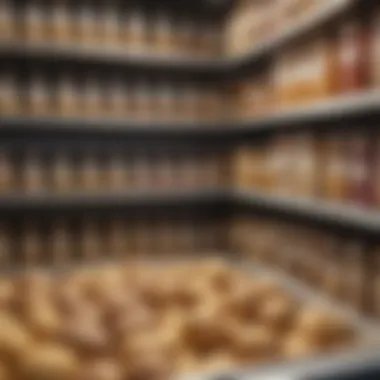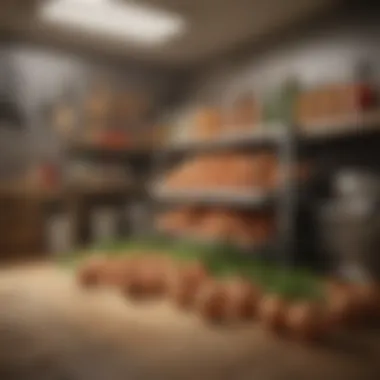Maximize Freshness: Pantry Bins for Potatoes & Onions


Intro
In the realm of home cooking, the effective storage of ingredients plays a pivotal role in maintaining the quality and longevity of food. Potatoes and onions are essential staples in numerous cuisines, yet they require careful consideration when it comes to storage solutions. Pantry bins have emerged as a functional option to optimize the preservation of these vegetables, ensuring they remain fresh and usable for extended periods. This section will explore the characteristics of potatoes and onions, their storage requirements, and the benefits of utilizing pantry bins.
Potatoes thrive in cool, dark, and well-ventilated spaces. Exposure to light can lead to greening, which affects both flavor and safety. Onions, similarly, need a dry environment to prevent sprouting and mold growth. Combining these storage needs, pantry bins serve as an ideal solution due to their design and functionality. They offer an organized, designated space for these vegetables, minimizing waste and enhancing accessibility.
This article aims not only to clarify the role of pantry bins but also to provide practical organization strategies for the discerning home cook. It delves into the optimal conditions for storage, the appropriate materials for bins, and innovative organizational methods. Understanding these aspects can greatly improve food preservation and culinary experiences at home.
Prelude to Pantry Storage
In the context of food preservation, pantry storage plays a crucial role. It not only affects the longevity of vegetables but also their flavor and nutritional value. Proper storage is particularly vital for staples such as potatoes and onions. These vegetables may seem robust but require specific conditions to stay fresh. Understanding these requirements can lead to better food choices and enhance culinary experiences.
Understanding the Importance of Storage
Storage is never just a mundane task. It is foundational to maintaining quality. Keeping potatoes and onions in appropriate conditions prevents spoilage and waste. The right environment slows down the deterioration process. For instance, improper storage may lead to sprouting or softening in potatoes, while onions can develop mold or soft spots. Thus, thoughtful storage can save money and improve health by ensuring consumed vegetables are at their best.
Common Challenges in Storing Vegetables
Storing vegetables effectively comes with challenges. Potatoes should be kept away from light; exposure can lead to greening and toxic solanine production. Onions require ventilation to prevent mold growth. Here are some recurring issues faced:
- Moisture Control: Excess humidity can cause rot, while too little can lead to shriveling.
- Temperature Fluctuations: Ideal temperatures must be maintained to prevent spoiling.
- Cross-Contamination: Storing potatoes and onions together can accelerate spoilage; they emit certain gases that harm each other.
Addressing these challenges requires a clear understanding and practical strategies. This article will delve into these details to optimize storage conditions effectively.
Characteristics of Potatoes
Understanding the characteristics of potatoes is essential for ensuring their proper storage. This section focuses on several specific elements that affect the longevity and freshness of potatoes. Key considerations such as ideal storage conditions and signs of spoilage will be examined closely. Knowing these factors allows home cooks to maintain the quality of potatoes effectively, leading to enhanced culinary experiences.
Ideal Storage Conditions
Light
Light exposure is a significant factor in the storage of potatoes. Potatoes should be kept in the dark. When exposed to light, they can develop green spots due to the formation of chlorophyll. This can be harmful as it indicates the presence of solanine, a toxic compound. By ensuring that the storage bins are opaque or located in dark, cool places, the risk of greening can be reduced. Light management is a simple yet important part of keeping potatoes fresh and safe for consumption.
Humidity
Humidity is another critical element affecting potato storage. Potatoes thrive in relatively humid environments, usually around 85-90% humidity. If the air is too dry, they may shrivel and lose moisture. However, excessive humidity can promote mold and decay. It is beneficial to regularly check the humidity levels in the storage area to find the right balance. Utilizing humidity packs can help maintain adequate moisture levels and prolong shelf life.
Temperature
Temperature regulation plays a crucial role in potato preservation. The ideal temperature for storing potatoes is between 45°F to 50°F (7°C to 10°C). At this range, potatoes can remain firm and fresh for an extended period. Storing them at cold temperatures, like in a refrigerator, can lead to sweetening and changes in flavor. Conversely, higher temperatures can encourage sprouting. Therefore, maintaining stable, cool temperatures is essential.
Signs of Spoilage
Sprouting
Sprouting is a clear sign that potatoes are past their prime. When potatoes begin to sprout, it often indicates that they are attempting to grow. This can happen when potatoes are stored in improper conditions. Although sprouted potatoes are not necessarily harmful, they can develop an undesirable taste. It is advisable to remove sprouts before cooking or eating.
Softening
Softening occurs when potatoes start to lose their firmness. When a potato feels mushy or pliable, it has likely begun to spoil. This can be caused by prolonged storage or exposure to moisture. Soft potatoes may have an undesirable texture when cooked, making them less appealing in recipes. Regular checks on potatoes can help catch this spoilage early.
Discoloration
Discoloration can manifest in various forms, such as browning or the appearance of dark spots. This often signals that the potato is no longer fresh. While some blemishes can be cut away, widespread discoloration typically indicates decay. Monitoring potatoes for such changes before cooking can help maintain quality and taste in dishes.
Characteristics of Onions
Understanding the characteristics of onions is crucial for proper storage. Onions have specific needs to maintain freshness and quality. With the correct storage conditions, both their flavor and lifespan can be significantly enhanced. This section provides a comprehensive look at the ideal storage conditions and spoilage signs that affect onions, which is vital for effective pantry organization.


Ideal Storage Conditions
Ventilation
Ventilation is an essential factor in onion storage. Proper airflow prevents moisture buildup, which can lead to rot. When onions are stored in sealed containers, they can suffocate and develop mold. A well-ventilated storage unit allows onions to breathe, extending their usable life. **Key characteristics of good ventilation include:
- Airflow: Increased airflow works against humidity absence.
- Placement: Storing onions in breathable baskets or wire racks promotes circulation.
Ventilation is beneficial for preserving the integrity of onions and reducing spoilage risks. However, inadequate ventilation can lead to spoilage, making it an important consideration in pantry bin selection.
Temperature
Temperature is another crucial element in onion preservation. Onions preferably thrive in cool environments, ideally between 32°F to 40°F. Exceeding this range can accelerate spoilage, reducing both flavor and usability. Importance of maintaining the right temperature includes:
- Flavor Retention: Cool temperatures help maintain the natural sweetness of onions.
- Longevity: Proper temperature can extend the storage period, possibly up to several months if conditions are right.
Conversely, high temperatures lead to sprouting and softening, negatively impacting their textural quality. Therefore, selecting pantry bins that allow temperature control is vital for maintaining onions.
Light Exposure
Light exposure plays a significant role in onion storage, as onions prefer dark environments. Exposure to light can cause onions to sprout green shoots, reducing flavor and usability. Key aspects of managing light exposure include:
- Opaque Bins: Using containers that block light can effectively slow down sprouting.
- Storage Location: Ideally, onions should be stored in a dark area of the pantry or kitchen cabinet.
However, completely sealing onions away from light can lead to moisture accumulation, which can be detrimental. Finding a balance is essential for preventing sprouting while still keeping onions in good condition.
Signs of Spoilage
Mold
Mold on onions is a significant sign of spoilage, indicating that conditions were not optimal. Mold growth often occurs due to excess moisture and poor ventilation. It is a serious issue because it can spread quickly to other stored produce. Notable points regarding mold include:
- Health Risk: Consuming moldy onions can lead to foodborne illnesses.
- Identify Early: Checking for mold regularly can prevent widespread spoilage.
The presence of any mold should prompt immediate action, such as removing affected onions and evaluating storage conditions for necessary adjustments.
Soft Spots
Soft spots are indicators that an onion is no longer fresh. They usually result from moisture exposure or damage that leads to decomposition. Key insights about soft spots involve:
- Textural Change: Soft areas indicate that rot may be starting.
- Waste Management: Onions with soft spots should be used quickly or discarded to prevent further spoilage.
Identifying soft spots early is essential to ensure that they don’t ruin other healthy onions in storage.
Sprouting
Sprouting onions, while not necessarily harmful, significantly alters their flavor and texture. When onions sprout, the taste tends to become more bitter and less appealing. Characteristics of sprouting include:
- Replacement Indicator: Sprouted onions are nearing the end of their usability. Timely use or disposal is advisable.
- New Growth: If the sprout is cut off, the remaining onion can still be used, but it is wise to monitor its quality.
Managing sprouting through proper storage methods can enhance the longevity of onions, allowing them to be enjoyed longer in the kitchen.
By understanding these key aspects of onion storage, you can make better choices when organizing your pantry. Ensuring optimal ventilation, temperature control, and light exposure can lead to fresher, longer-lasting onions.
Types of Pantry Bins for Storage
Choosing the right pantry bins is vital for storing potatoes and onions effectively. These bins play a significant role in maintaining the ideal conditions for keeping these vegetables fresh for extended periods. This section will delve into the different types of bins available, focusing on material considerations and size and shape selection.
Material Considerations
Plastic vs. Metal


When it comes to choosing between plastic and metal bins, there are several factors to consider. Plastic bins are lightweight and often more affordable. They are easy to clean and come in various sizes and shapes, making them versatile for different storage requirements. One key characteristic is that they are less prone to rust or corrosion, which can be a big advantage in a damp environment. However, they may not provide as much breathability as metal bins, which can lead to moisture accumulation.
On the other hand, metal bins offer durability and stability. They are generally more robust and can handle heavier loads, which is useful for bulk storage. Metal bins often have better ventilation, which helps in reducing excess humidity. The disadvantage lies in their heavier weight and susceptibility to rust if not coated properly. Therefore, both materials have unique features that cater to different needs and preferences.
Wooden Bins
Wooden bins present a classic option for vegetable storage. They provide excellent ventilation, which greatly benefits potatoes and onions as they need air circulation to prevent spoilage. A key characteristic of wooden bins is their aesthetic appeal; they can enhance the look of a pantry while being functional. They are often designed with slats or open designs, allowing air to flow freely.
However, wooden bins can absorb moisture, which may lead to mold growth if not properly sealed or maintained. Over time, they may require additional care to prevent wear and tear. In terms of renewability, wood is an eco-friendly choice, which may be appealing to environmentally conscious consumers.
Wire Baskets
Wire baskets offer a practical solution for storing potatoes and onions. They are lightweight and allow for optimal air circulation, reducing the risk of mold or rot. The key characteristic of wire baskets is their structured design, which ensures that the vegetables do not become cramped, allowing them to breathe.
These baskets can be stacked, helping to maximize storage space in a pantry. One unique advantage is their transparency, making it easier to see the contents without opening. However, they may not protect the vegetables from light exposure as effectively as solid bins. Overall, wire baskets serve as a functional and efficient option for vegetable storage.
Size and Shape Selection
Capacity Needs
Capacity is a crucial factor when selecting pantry bins. It refers to how much produce can be stored in a bin at any given time. Knowing your capacity needs ensures that you can store enough potatoes and onions to avoid frequent trips to the store. Larger bins can handle bulk purchases, reducing the frequency of shopping, which is particularly useful in home cooking.
On the flip side, smaller bins may be more suitable for limited space or for those who consume vegetables at a slower rate. Understanding how much storage is necessary helps in making informed choices about the optimal size.
Space Constraints
Every kitchen has its limitations when it comes to space. Thinking about space constraints helps consumers choose the right bins that fit in their pantry without overcrowding. Compact bins can be essential for smaller kitchens, allowing for a cleaner and more organized storage solution.
When space is at a premium, stackable bins can be especially beneficial. They enable the use of vertical space efficiently, freeing up room for additional pantry items. Planning for space not only facilitates easier access but also aids in overall organization.
Design Appeal
Finally, the aesthetic aspects of pantry bins cannot be ignored. The design appeal of bins should reflect individual style while serving practical purposes. Decorative bins can enhance the visual interest of a pantry area. Stylish storage solutions can also motivate individuals to keep their storage organized.
However, it is essential to balance aesthetics with functionality. Bins must fulfill storage roles while also blending into the kitchen's decor. Investing in visually appealing but practical bins can elevate the overall aesthetic of a culinary space.
Best Practices in Organizing Storage Areas
Effective organization is key to enhancing the longevity and freshness of pantry staples like potatoes and onions. Using proper storage techniques reduces waste and allows easy access to ingredients when needed. Understanding how to utilize the space in a pantry can optimize food preservation and accessibility, making cooking more efficient. Without a well-organized system, it is easy for these vegetables to spoil, wasting not just money but also ingredients.
Maximizing Vertical Space
Stacking Bins
Stacking bins are an effective solution to conserve floor space while allowing for organization. By utilizing vertical space, you maximize your pantry's potential. Each bin can be dedicated to specific types of potatoes or onions, which allows for better airflow and visibility.
A prominent characteristic of stacking bins is their ability to nest securely without compromising stability. This makes them a beneficial choice in environments where space is at a premium. The unique feature of these bins is often their tapered design, allowing them to stack neatly. Their advantages include easy access and clear labeling, but careful management is required to ensure that the bins at the bottom receive necessary ventilation.
Use of Shelves
Shelves can transform a crowded pantry into an organized haven for food storage. By installing shelves, you can adjust the height according to your needs, allowing for larger bins or smaller containers as necessary. Shelves promote air circulation, which is crucial for storing onions and potatoes effectively.
A key characteristic of using shelves is their versatility; you can place various sizes and types of storage containers. This adaptability makes them a popular choice in many pantries. The unique aspect of shelves is their ability to hold a variety of bins and baskets, facilitating easy access. The primary downside might be the initial setup, as installing shelves requires some effort and planning.
Easy Access and Rotation Techniques
FIFO Method
The FIFO (First In, First Out) method is a systematic approach to manage food storage effectively. With this technique, older items are used before newer ones, which minimizes waste and preserves the freshness of your potatoes and onions. The critical aspect of FIFO is its simplicity: you just place the newest items behind the older ones. This method is beneficial because it encourages timely usage of all stored products.


The unique benefit of the FIFO method is that it helps maintain an organized and efficient pantry since you can see at a glance what needs to be used. However, it may require initial effort to set up and remember to rotate your items as you add new ones.
Organizing by Size
Organizing by size means placing larger potatoes and onions in one bin or shelf and smaller ones in another. This technique aids in visibility and access, ensuring that you do not have to rummage through mixed sizes. The key characteristic of this method is that it allows for a structured yet straightforward organization that can speed up meal prep time.
The unique feature of organizing by size is that it helps prevent damage to smaller vegetables, which can be crushed under heavier items. While this organization method is effective, it may require frequent reassessment as vegetables vary in size over time.
Proper organization of pantry storage can significantly extend the life of your potatoes and onions, improve air circulation, and ultimately enhance your culinary experience.
Food Preservation Strategies
Food preservation is key for extending the life of potatoes and onions. By understanding preservation strategies, one can effectively manage storage conditions to maintain freshness. Proper food preservation not only reduces waste but also ensures that these staples retain their flavors and nutritional value over time. The goal is to create an environment that slows down spoilage and enhances shelf life.
Maintaining Humidity Levels
Maintaining appropriate humidity levels in storage is crucial for the longevity of potatoes and onions. High humidity can encourage mold growth, while low humidity may lead to shriveling.
Humidity Packs
Humidity packs are a solution to control the moisture level effectively. These packs absorb excess moisture and release it when humidity drops too low. The key characteristic of these packs is their ability to regulate humidity without making it too high.
One advantage of using humidity packs is their ease of use. They are often pre-packaged and require little maintenance. However, one must remember to replace them periodically, as they do lose effectiveness over time.
Periodic Checks
Conducting periodic checks on the storage environment can help ensure the right conditions are maintained. This entails monitoring both humidity and general overall condition of the stored items. Regular checks help identify any signs of spoilage early, allowing for timely intervention.
A key characteristic of periodic checks is that they encourage a proactive approach. Home cooks can catch problems before they escalate. Although this method does require time and awareness, the benefit of maintaining optimal conditions outweighs the effort involved.
Temperature Control
Temperature control is another pivotal aspect of food preservation. Potatoes and onions have specific temperature ranges at which they can be stored effectively to prevent spoilage.
Optimal Ranges
The optimal temperature ranges for storing potatoes are generally between 45 and 50 degrees Fahrenheit. For onions, a slightly higher range of 32 to 40 degrees Fahrenheit is effective. The benefit of knowing these ranges means that one can adjust the storage area, potentially using a small refrigerator or a cool basement to create ideal conditions.
A unique feature of maintaining these optimal ranges is that it allows a person to take advantage of seasonal temperature fluctuations. A cool autumn can provide natural conditions for preservation.
Seasonal Considerations
Seasonal considerations involve adapting storage practices based on environmental changes throughout the year. In winter, lower temperatures outdoors may not always equate to optimal storage conditions. Adjustments may be necessary during summer months to avoid exceeding recommended ranges.
Such considerations can be beneficial as they promote a dynamic approach to food storage. However, vigilance is required, as it can be easy to overlook changes in an evolving climate.
By understanding and applying these preservation strategies, home cooks can significantly extend the freshness of potatoes and onions, enhancing their culinary experiences.
Culmination and Key Takeaways
When it comes to pantry bins, key elements include the materials used, size, and design appeal. Each choice influences the storage environment for potatoes and onions, ultimately affecting their longevity and health. Proper ventilation, temperature control, and light exposure are integral in preventing spoilage. These specific needs highlight the importance of thoughtful organization. In this way, maximizing the storage area leads to better usage of space, which can help prevent waste.
Adopting effective food preservation strategies will enhance not only the culinary experience but also sustainability practices in the kitchen. A well-organized pantry that utilizes suitable storage bins can make the difference in achieving these goals.
As a final thought:
A little effort in understanding storage needs pays off with fresher ingredients and reduced waste.
Summary of Best Practices
- Choose the Right Material: Use bins made of breathable materials, such as wire baskets or wooden bins, to promote air circulation.
- Control Environmental Conditions: Aim for a cool, dark, and well-ventilated space. Avoid areas with moisture and direct sunlight.
- Regularly Inspect Your Stock: Routinely check for signs of spoilage, and remove any affected items to prevent spreading.
- Implement Organizational Techniques: Utilize stacking strategies and FIFO (First In, First Out) methods for easy access and management.
- Adapt Storage Strategies Seasonally: Be mindful of changing temperature and humidity as seasons change, adjusting your pantry accordingly.
Encouragement for Implementation
Taking the steps outlined in this article is not just beneficial; it is practical and achievable. Consider starting small, perhaps by redesigning a single shelf or bin for your potatoes or onions. Observe the effects this has on the freshness of your ingredients. Establish a new habit of regularly checking storage conditions and adapting them as necessary.
Implementing these strategies encourages better food practices. It enables individuals, regardless of cooking ability, to improve their kitchen management. When the basics of storage are understood and put into action, they pave the way for a more enjoyable culinary experience overall.















